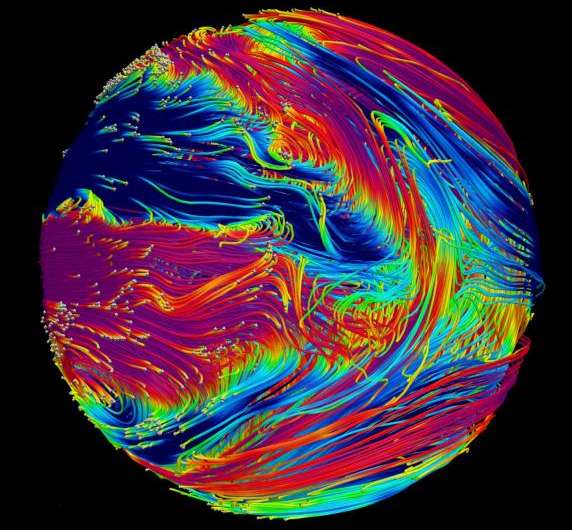This image shows magnetic field lines in the atmosphere of a hot giant exoplanet. Time snapshot of magnetic field lines in the numerical simulation of a hot giant exoplanet atmosphere (a model of HD209458 b, but with a temperature structure similar to HAT-P-7 b). Magnetic field lines are colour-coded to represent the azimuthal (toroidal) magnetic field, with blue representing a negative-directed field (saturated at − 50 G) and magenta representing a positive-directed field (saturated at 50 G), with green and yellow ranging from − 5 to 5 G, respectively. The vantage point is looking onto the east-side terminator.
Senior Scientist Tamara M. Rogers of the Planetary Science Institute has discovered that substantial variability in the winds on the hot giant exoplanet HAT-P-7b are due to magnetism, and used those measurements to develop a new method to constrain the magnetic field of such an object.
HAT-P-7b was discovered by NASA's Kepler Mission in 2008. It is nearly 40 percent larger and nearly 80 percent more massive than Jupiter. It orbits its star every couple of days, and is so close that dayside temperature may be 2,200 degrees Kelvin (3,500 degrees Fahrenheit) with a night side 1,000 Kelvin (1,340 degrees Fahrenheit) cooler.
This strong day-night temperature difference drives strong eastward winds in the atmosphere and shifts the hottest temperature away from the point directly beneath the star on the dayside. However, this hot spot shifts significantly over time – even ending up on the west side of the sub-stellar point. This means that the winds are also changing significantly.
"The extreme temperatures of HAT-P-7b ionizes alkali metals such as lithium, sodium, and potassium, which results in the coupling of the atmosphere to a deep-seated magnetic field. Magnetic forces are able to then disrupt the strong eastward winds, leading to variable and even oppositely directed winds," Rogers said.
Rogers used a hydrodynamic model of the atmosphere in combination with a magnetohydrodynamic (MHD) model to reproduce the observed variations in the hot spot location, thereby setting a minimum value for the strength of the magnetic field of this planet at six times that of the Earth.
"Long timeline or multiple epoch observations of hot giant exoplanet phase curves coupled with MHD models of the atmospheres of these planets, can be used to place constraints on the magnetic field strengths of other hot giant exoplanets," Rogers said. "This will provide new insights into dynamo theory, planetary evolution and interpretations of star–planet magnetic interactions."
Rogers' paper "Constraints on the magnetic field strengths of HAT-P-b and other hot giant exoplanets" appears in Nature Astronomy.
More information: "Constraints on the Magnetic Field Strengths of HAT-P-b and Other Hot Giant Exoplanets," Tamara M. Rogers, 2017 May 15, Nature Astronomy www.nature.com/articles/s41550-017-0131 , Arxiv: arxiv.org/abs/1704.06271
Provided by Planetary Science Institute
























